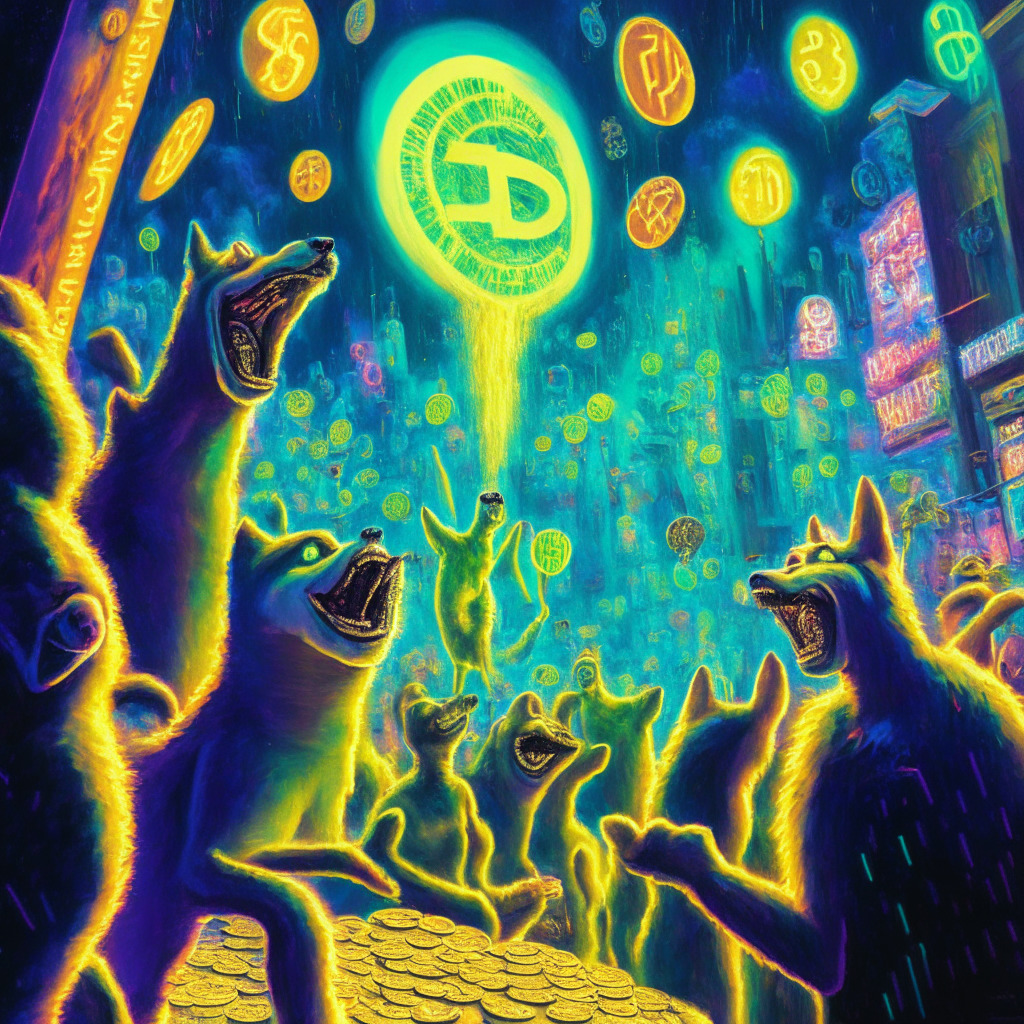“The Department of Justice (DOJ) has dropped a campaign finance charge against FTX founder Sam Bankman-Fried. This followed a consultation with The Bahamas, as extradition under U.S treaty required their explicit consent. Bankman-Fried, embroiled in allegations of unlawful political contributions, allegedly used funds from Alameda Research to manipulate politics.”
Day: July 27, 2023
The Intriguing Prologue of Central Bank Digital Currencies: Boon or Bane?
Central banks worldwide are exploring Central Bank Digital Currencies (CBDCs): digital versions of their currency eliminating intermediaries. This development claims cost-saving potential and policy-making tools but carries risks. Without private banking, government surveillance increases, the market economy may stagnate, and individual protections decrease. Politically-motivated fund allocation also becomes possible. Therefore, while CBDCs may appear attractive, comprehensive discussions around the dangers and ethical use are needed.
Sequoia Capital Trims Crypto Investment by 65%: Strategic Shift or Declining Faith?
“Sequoia Capital has reduced its cryptocurrency investment allocation by a notable 65%, down to $200 million from $585 million, as part of a revised approach influenced by the shifting crypto market’s dynamics. This adjustment reflects a trend of VCs nurturing startups rather than backing mature firms.”
Unlocking the Future: Optimism’s Beam Wallet Redefines Crypto Transactions
“Step into the future with blockchain-based Beam wallet. This innovative application uses Twitter for login, eliminating the need to store seed words. Backed by top Web3 venture capitals, it aims to enhance user experience, increase adoption rate and ensure security by not landing passwords on a centralized server.”
Cryptocurrency Crossroads: Santos Scandal Meets RFK Jr’s Bitcoin Vision
“The Santos incident reveals a complex intertwining of political intrigue, crypto manipulation, and scams, while figures like Robert F. Kennedy Jr. demonstrate a supportive stance towards cryptocurrency. This highlights the intersection of politics, regulation, and digital finance in unanticipated ways.”
Worldcoin’s Irony: Promising Security yet Falling Prey to Deception
Blockchain security was recently challenged on a rebranded social media platform, with numerous scam accounts launching under the Worldcoin banner. These counterfeit accounts shared devious links, jeopardizing users’ security. Despite this, Worldcoin continues striving towards its goal of differentiating real people from bots.
Deciphering the Complex Dance: Bitcoin’s Future and the Robust U.S Economy
“The U.S economy’s robust performance has sparked interest in Bitcoin amidst financial stability in traditional markets. Bitcoin’s value remains hard to predict. However, technical analysis suggests the digital currency could see continued bullish trends, provided it can maintain key supports. Still, market volatility and unpredictable factors render personal research crucial.”
Crypto to the Rescue: Dissecting Debanking, Financial Liberties and the Rise of Cryptocurrencies
“This episode highlights the long-standing practice of banks denying services based on arbitrary reasoning, an issue familiar to the crypto community. Crypto advocates push for innovations that remove human bias from banking decisions, seeing cryptocurrencies as the solution to financial censorship. Yet, as numerous individuals are debanked annually, the question of institutional accountability lingers.”
Wyoming’s Revolutionary Leap: State-backed Stablecoin Project and a Hefty Paycheck Higher than the Governor’s
The US state of Wyoming plans to hire an executive director for a groundbreaking stablecoin project, a commission introduced after the Wyoming Stable Token Act was recently approved. The commission’s authority allows it to issue a US dollar-pegged stablecoin in Wyoming, redeemable for dollars in the state’s bank account. With desired qualifications including blockchain expertise and understanding of Wyoming’s legislative operations, the Commission aims to issue a stablecoin by end of 2023.
The Blockchain Dance-Off: Optimism Outperforms Arbitrum in Transaction Volume Reversal
Optimism, a Layer-2 solution for Ethereum utilizing optimistic rollup technology, has surpassed its rival Arbitrum in terms of transaction volume for the first time in six months. This was largely driven by the launch of Worldcoin on Optimism and a reduction in transaction fees due to Optimism’s Bedrock upgrade. However, Optimism still trails Arbitrum considering the total value locked within contracts.
Global Tours of Tokenized Real-World Assets: Exploring Blockchain Opportunities and Challenges
This week spotlighted tokenized real-world assets (RWAs), an area projected to reach a $16 trillion market by 2030. Companies like Avalanche are encouraging this trend, while nations like Spain, Colombia, and Hong Kong innovate with equity tokens, decentralized finance, and real estate asset tokenization. Blockchain adoption shows vast potential for growth and inclusivity.
Navigating Crypto Legislation: Can the New U.S Federal Regulatory Framework Provide Clarity?
“The Financial Innovation Technology for the 21st Century Act, aimed at establishing a federal regulatory framework for cryptocurrency, has been forwarded to the full House of Representatives. This addresses the current industry confusion caused by a lack of explicit regulations, by providing clarified guidelines for crypto ventures.”
Unraveling the Knots of US ‘Pro Crypto Bill’: Progress and Objections Explained
“The ‘Pro Crypto Bill’ recently advanced from the US House Agriculture Committee, aiming to set a comprehensive regulatory structure for digital assets. While promising for the regulated crypto environment, critics express concerns over its lack of third-party auditing provision and stagnant CFTC funding.”
The Worldcoin Enigma: A Revolution in Identity Protocol or a Privacy Nightmare?
Worldcoin, an innovative platform created by Sam Altman, promises to make cryptographic currencies more dispersed than Bitcoin. Boasting a unique identity protocol using iris scans and AI, it aims to onboard billions of users into crypto markets. However, concerns about privacy, tokenomics, and regulatory challenges have arisen, prompting questions about the future of such revolutionary blockchain projects.
Bold Projections for Bitcoin: Yusko Predicts $300,000 Value by 2028, But is it Plausible?
Mark Yusko, CEO at Morgan Creek Capital Management, predicts that by 2028, Bitcoin could reach a value of $300,000, equivalent to the monetary value of gold. His prediction is based on Bitcoin’s portability, divisibility, scarcity, and halving process, which systematically reduces the reward for mining a block by 50% every four years to control new Bitcoin supply and support price growth. Despite Bitcoin’s current volatility, other experts also foresee significant price increases.
Stablecoins Disrupting Financial System: Are They Really Riskier than Bank Deposits?
According to former Federal Reserve Board analyst, Brendan Malone, stablecoins are less risky than bank deposits and are not akin to money market funds. He argues that stablecoins, backed by fiat currencies and typically short-dated Treasuries, do not pose similar risks as banks due to the absence of mismatches between short-term liabilities and long-term assets. Regulating stablecoins similarly to traditional financial entities could, however, limit competition and increase market dominance.
Unmasking the Two Faces of DeFi: The Lure of Freedom and the Lingering Concerns of Safety
“Decentralized finance (DeFi) brings transparency and freedom from centralized authorities, yet lack of regulatory oversight leaves safety in question. Despite allowing for more financial services and privacy, DeFi carries potential risks, including loss of funds due to wrong transactions or lost keys.”
Decoding Cryptocurrency Market Reactions: Analyzing Shifts to Meme Coins & Emerging Risks
The Federal Reserve’s recent interest rate hike had a subdued impact on Bitcoin and Ether but spotlighted Ethereum-based coins like the HUTAO, PAAL AI and Hoppy. However, these speculative coins, despite short-term gains, potentially carry significant risks due to their lack of sturdy utility or project vision.
Shaping the Future of Renewable Energy: The Unforeseen Role of Bitcoin Mining
“Bitcoin mining appears as an unexpected solution to the ‘duck curve’ – mismatch of peak energy demand and production times. By absorbing excess energy during high production periods, Bitcoin miners help balance grid management, enhancing profitability of renewable infrastructure and contributing to a sustainable future.”
Crypto Competition Uptick: Web3 Wallet Suku vs Twitter’s Vision for Crypto Payments Integration
Web3 wallet Suku is integrating with Twitter to allow users to easily send digital currencies and non-fungible tokens (NFTs). It aims to simplify the crypto onboarding process, bypassing the need to connect a wallet. Furthermore, Suku plans to integrate with other social media platforms, striving to create a decentralized payment system that works across various platforms. Despite the challenges, crypto payments on social media are on a promising trajectory.
BTC20: The Breakthrough Token Outpacing Bitcoin and Pepe Coin in Google Trends
The ERC-20 token, BTC20, is exceeding both Pepe coin and Bitcoin in popularity and has gathered over $3.4 million in presale in just nine days. Offering potential yields up to 520%, it attracts investors with the concept of owning bitcoin on the Ethereum blockchain at bitcoin’s original 2011 price with added environmental benefits.
Stablecoin Policy Disputes: A Milestone or Impediment for Crypto Regulation?
“The Clarity for Payment Stablecoins Act (H.R. 4766) negotiations spark political debate. While some view this potential legislation as crucial for cryptocurrency regulation, others express concern about rushed decisions, lack of oversight, and regulatory dissonance. Rep. Warren Davidson’s ‘Keep Your Coins Act’ also enters the conversation, aiming to protect individual’s self-custodied crypto wallets.”
Unveiling Crypto Investments: Exploring the Balance between Passive and Active Strategies
Approximately 13% of over 320 million global crypto owners are American, highlighting a growing interest in digital asset investment. With the increasing need for advisor support in managing crypto investments, it’s crucial for financial advisors to understand clients’ options. Strategies include investing in stocks of publicly traded companies with digital asset exposure, Blockchain-themed ETFs, and liquid tokens. But dichotomy exists between passive ‘HODL’ approach and active managers seeking diligent outperformance. Crypto’s volatility can aid active managers in identifying long-term appreciation potential. Despite still nascent, the crypto market offers increasingly diverse investment options.
Revolutionizing Crypto Investments: An In-Depth Look at Launchpad XYZ’s AI-Powered Platform
“Launchpad XYZ, leveraging AI-powered price prediction tool, aspires to ease high-value crypto investments by providing data, insights, and analysis. Its native coin $LPX is for availing premium features and covering transaction fees. It introduces NFT mint whitelisting, facilitating users access to new collections backed with critical metrics.”
Navigating the Crypto Market: Bulls, Bears, and the Risky Business of ‘Pigs’
“Bulls, bears, and ‘pigs’ shape the crypto market dynamics with their varying tendencies. Successful blockchain investment lies in a balanced approach – blending long-term investments and short-term trades. Crucial to navigate this volatile market is effective risk management, continuous learning, and adaptation, avoiding the pitfalls of excessive risk-taking.”
Optimism Surpasses Arbitrum in Daily Transactions: The Tale of Two Blockchains
“Blockchain layer-2 Optimism surpassed Arbitrum in daily transactions, largely thanks to the emergence of Worldcoin. Despite Optimism’s transaction rates, it trails in daily active wallets compared to Arbitrum. The competition between these two demonstrates the evolving nature and diverse directions of blockchain technology.”
Crypto Assets: Property or Currency? Unpacking Singapore’s High Court Verdict
“Cryptocurrency value derives from collective human perception, Judge Philip Jeyaretnam stated in a Singapore High Court verdict that equated digital currencies with fiat money. His ruling, recognizing crypto assets as property despite their incorporeal nature, could initiate a sea change in cryptocurrencies’ legal status.”
Stablecoins Legislation Deadlock: A Battle for Supervision and Inclusion in Crypto-World
“The debate in the House over stablecoins legislation reveals the significance of addressing regulatory ambiguity in the digital asset sector. Despite disagreements, legislators acknowledge the importance of stablecoins, and the outcome of this issue will inevitably influence its future regulation.”
The Thrills and Spills of Home Crypto Mining: Endurance Amid Industry Giants
The world of crypto mining has evolved into a dominion of large-scale mining and finance behemoths, making individual mining increasingly doubtful due to high electricity and equipment costs. Despite these challenges, diehard enthusiasts continue to innovate solutions, believing in the potential of the crypto market.
Meme Coin Market Surges: Is Dogecoin Outperforming, or is a Consolidation Imminent?
The meme coin market is showing significant activity, with Dogecoin and Pepecoin experiencing considerable price jumps. A new platform, yPredict, utilizes AI to provide predictive market trend analyses, aiming to aid retail traders. However, in this high-stakes market, due diligence is essential.
Digital Assets in War: Analysing Ukraine’s Crypto Boost amid Russian Conflict
Ukraine has benefited from the decentralized nature of cryptocurrencies amid the Eastern European conflict, with $225 million worth flowing into the country for essentials such as weaponry and medical supplies. Despite slowing donations, financial backing persisted. Notably, most contributions geared towards humanitarian initiatives than military operations. USDT emerged as the primary donation currency, followed by Ether, Bitcoin, and others. Contrastingly, Russia’s crypto fundraising has been lesser and subtle. Technology and economic strategy in crisis times aren’t free from potential manipulations and concealed transactions.
Legal Battles Heat Up: EOS Network Foundation Plans Lawsuit against Block.one
The EOS Network Foundation gears up for a lawsuit against Block.one for failing to invest $1 billion from its 2018 $4.1 billion raise, causing complications for the EOS community. Despite the risks of litigation, this prompts a broader conversation about compensatory justice in cryptocurrency.































